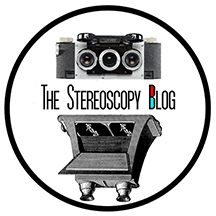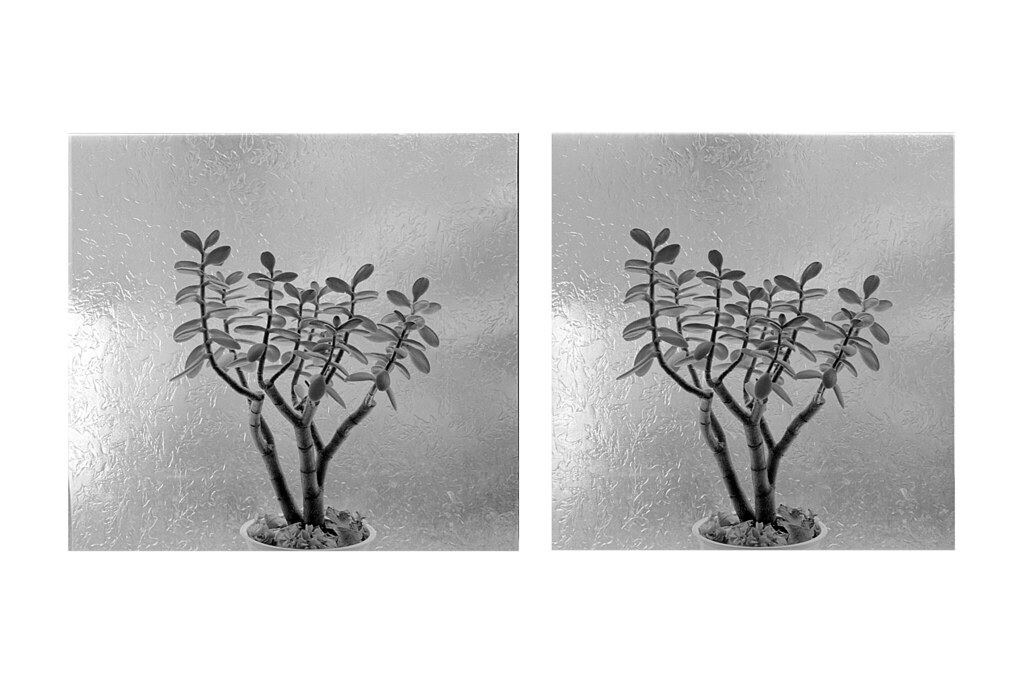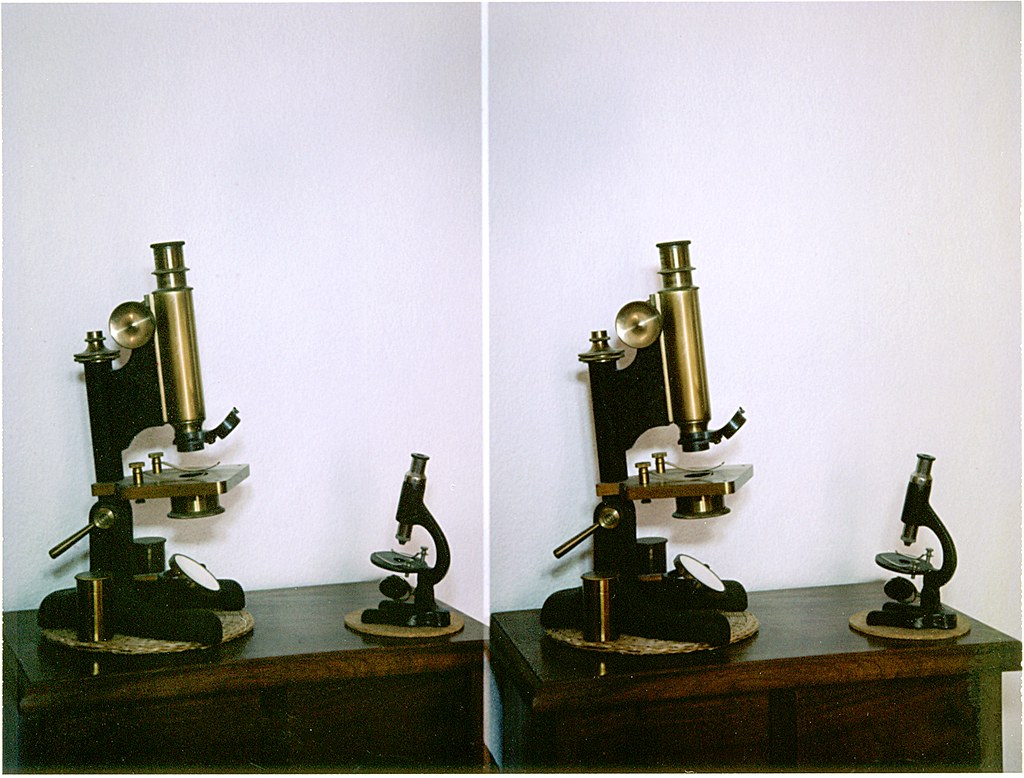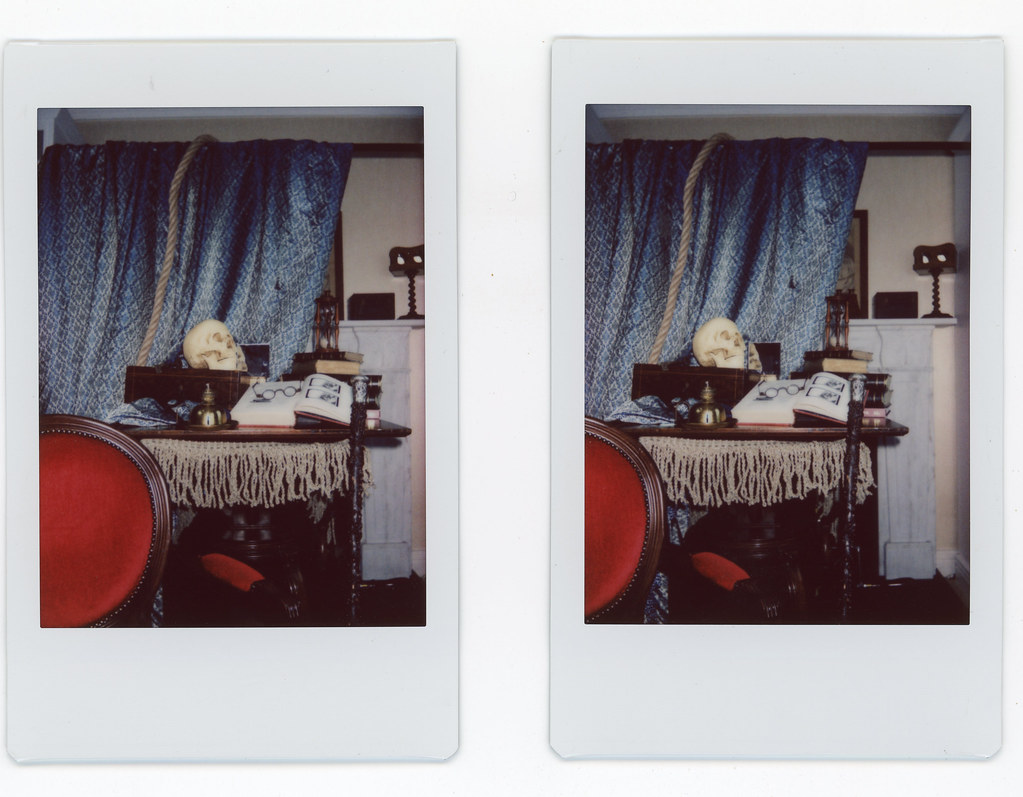I’m excited to welcome to the Stereoscopy Blog John Furlong, who contacted me recently to ask if the Blog would like him to contribute an article about how he has made instantaneous stereoviews from a Polaroid passport camera. I really enjoy learning how people make stereos from equipment which wasn’t intended for that purpose, so of course I jumped at the chance to share his post! It reminds me how some of the Victorian Carte de Visite multi-lens camera negatives have been used to make ‘accidental stereoviews’, but this time the photographer is doing it on purpose.
Thank you so much John, I’m going to have to restrain myself from looking at Polaroid passport cameras because this is a brilliant way to use them.
By John Furlong
Polaroid made a number of cameras specifically for producing passport photographs.
Early versions gave two images side by side on one print, later variants produced four images per print with the option of making four separate exposures on the same print. More up to date versions used a video camera linked to a printer which transferred the video image on to a Polaroid print – up to 9 images on one print!
Over time, all the cameras became obsolete as the required format for passport images altered, and ultimately the Polaroid company ceased to exist. The type of film used in the majority of the passport (and many other Polaroid) cameras continued to be produced by Fuji, but 2016 saw the end of production of that type of film (so called ‘pack film’). These films can still be found on eBay – at eye-watering prices!
John’s Polaroid MiniPortrait 253 camera
As mentioned above, the basic camera (MiniPortrait 202) produces two images side by side on one print. In a ‘light bulb’ moment it suddenly dawned on me that this could offer the potential for a stereo pair – forget about steely-eyed mug shots!
Closer inspection of the camera revealed that the distance between the lens centres is approximately 48mm. The generally accepted dimension for optimum stereo imaging is around the 60~65mm mark – to emulate the average distance between the human eye centres (no allowance for interbreeding…). I sometimes wonder about the validity of that distance as I have that lovely little Italian stereo camera (Super Duplex 120) whose lens centres are a mere 30mm…its results are perfectly acceptable.
A quick test using some of my remaining modest hoard of Fuji ‘pack film’ in the MP 202 showed that 48mm produced a perfectly acceptable stereo pair. However, the diminishing (and increasingly expensive) stocks of that film made the whole idea a bit of a waste of time.
Fortunately, an exploration of eBay unearthed even more variants of the two and four lens variety of the MiniPortrait camera. Polaroid produced two other models which, instead of using their proprietary type of film holder, were capable of accepting a ‘Graflex back’. This is an industry standard fitting which allows the use of roll film (120) backs and 5×4 sheet film ‘double dark slides’ – film for both of which is still readily available.
Camera spec.
A Model 253 MiniPortrait camera (two lenses with a Graflex back) was duly purchased from Romania – shipping cost was more than the camera! As the Graflex back is larger than Polaroids’ proprietary back, the overall dimensions of the camera are greater than the basic 202 model. Although this results in an even heavier camera, (2.2Kg without a film holder!) there is the added advantage that the distance between the lens centres is greater – approximately 53mm – a bit nearer the magical 60mm.
There is a basic limitation common to all the Polaroid passport cameras – they’re fixed focus (camera to subject distance of 1.27m maximum, 1.9m with supplementary lenses) to ensure standard mug-shot sizes. Polaroid very helpfully incorporated a tape measure into the camera body with red line marks at 1.27 and 1.9m.
This means the stereo imaging will be limited in its scope – but so what!
The camera has 2 shutter speeds (1/60th and 1/125th) and ‘B’, and aperture settings of f/8, f/11,f/16, f/22 and f/32. It also has a standard flash sync socket with a cold shoe mounted on top of the viewfinder. The shutter is fired via the proprietary grip and cable on the side of the camera – the cable can be replaced by a standard shutter release cable if required.
Stereo images
I have a 120 roll film holder that’s capable of creating 6x12cm images and so was able to test the feasibility of getting stereo pairs on standard roll film (6 pairs per film). Some caution is needed in composing the image as 120 film is a good deal smaller than the image size (5×4 inches) for which the camera is designed.
The mono stereo pair image of a plant was produced using Ilford FP4+ in the 120 roll film holder.
Images taken with the Polaroid 253 MiniPortrait camera, Graflex 120-film adapter back and Ilford FP4+. Photos have been transposed to make a parallel-view stereocard.
There is another larger type of ‘pack film’ (FP100 C45 approximating to 5×4 sheet film) the holder for which can be fitted to the Graflex back. I’ve got one of them and an even more modest hoard of the film and have made a couple of tests using it. The two colour images are scans of the original Fuji instant print FP100 C45 material as:
(a) exposure time was several seconds which resulted in a very blue-shifted image.
(b) the film is years out of date!
Much post-processing was employed…
Untransposed stereoview (cross-view) direct from the Polaroid 253 MiniPortrait camera and expired Fuji instant print FP100 C45.
The Graflex back also offers other options – the 5×4 double dark slide for 5”x4” sheet film or 5”x4” paper for direct positive prints.
Untransposed stereoview (cross-view) direct from the Polaroid 253 MiniPortrait camera and expired Fuji instant print FP100 C45.
I would loved to have been a fly on the wall in Polaroids’ marketing department when these cameras were being produced, as their introduction would have been contemporary with the interest in stereo photography based on 35mm cameras – many of which were produced in the USA. Did they agonise about presenting the basic two lens model as a stereo camera rather than something limited to passport photos…??
John Furlong

Copyright © The Stereoscopy Blog. All rights reserved.









Hi, I’m new to the blog, but I’m just throwing it out there that Fuji Instax mini or square instant prints are the perfect size for making stereo cards. You just glue them side-by-side to a 3×5 index card. Here’s a scanned example: https://www.flickr.com/photos/hsandler/51773481841/in/album-72157674884839827/
Howard
LikeLike
Welcome to the Blog Howard! I’ve done this too and yes they are! The only ‘problem’ I found with the Instax Mini is there is no thread to fix it to a slider bar on mine, so you either have to really carefully hold it and move, or carefully slide it across a level surface. It’s also very difficult to get them behind the ‘stereo window’ with the framing, unless you digitise and edit it. Still, lots of fun, readily available, quick and easy to use.

LikeLike
It’s possible with the Instax Mini 90, as it’s got a tripod bush. It might be possible to glue one of the tripod bush adapters on to the bottom of your Instax Mini.
John F.
LikeLiked by 1 person